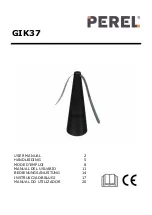
8. Continue to advance drainage catheter in small increments until catheter is
endoscopically visualized exiting endoscope.
NOTE: Elevator of endoscope must be open to allow drainage catheter to exit.
9. Under fluoroscopic monitoring, slowly advance drainage catheter to desired
position in biliary duct above obstruction.
10. When drainage catheter is in desired position, slowly remove endoscope while
holding drainage catheter and wire guide in place at patient’s mouth
CAUTION: Do not remove endoscope without removing the Tuohy-Borst
connector from the drainage catheter. Doing so may result in dislocation of
drainage catheter from the desired position in the biliary duct.
CAUTION: Do not remove endoscope without holding the drainage catheter
and wire guide. Doing so may result in dislocation of drainage catheter from
the desired position in the biliary duct.
11. Fluoroscopically confirm that drainage catheter and wire guide remain
positioned in biliary duct, then slowly remove wire guide in small increments
while maintaining position of drainage catheter.
CAUTION: Do not remove wire guide without maintaining the position of the
drainage catheter. Doing so may result in dislocation of drainage catheter from
the desired position in the biliary duct.
12. Lubricate the nasal transfer tube with a water-soluble lubricant approved for
medical use and advance through nostril until it exits in back of throat.
13. Grasp connection end of nasal transfer tube in throat and pull it out through
mouth (See Fig. 2).
14. If placing an 8.5 French or smaller catheter, lubricate the proximal end of
drainage catheter with water soluble lubricant if required. Thread the proximal
end of the catheter through the oral end of the nasal transfer tube and
advance until it exits through the nasal end or until it cannot be advanced any
further. If placing a 10 French or larger tube, securely connect the tip of the
tube to the oral end of the nasal transfer tube (See Fig. 3).
15. Hold drainage catheter, to prevent kinking and removal, and slowly pull
nasal transfer tube until nasal transfer tube is fully removed from nostril and
drainage catheter emerges through nostril (See Fig. 4).
CAUTION: Do not pull nasal transfer tube without holding the drainage
catheter. Doing so may result in kinking of drainage catheter or dislocation of
drainage catheter from the desired position in the biliary duct.
16. Disconnect/remove the nasal transfer tube from the drainage catheter.
17. Wipe any remaining lubricant from the proximal end of the drainage catheter.
18. Reattach Tuohy-Borst connector onto end of drainage catheter. Contrast may
be injected to check placement of catheter within duct.
7
Summary of Contents for NASAL BILIARY DRAINAGE SET
Page 2: ...1 2 3 4 2...
Page 3: ...5 3...
Page 9: ...A RT 5 2 4 1 5 For Drainage Only OFF 9...
Page 10: ...29 3 10...
Page 11: ...Cook RT 3 0 1 900 19 T m SAR 4 W kg 4 mm 3 T 4 mm 3 T 1 11...
Page 12: ...2 3 Luer 4 Tuohy Borst 5 6 7 8 9 10 Tuohy Borst 12...
Page 13: ...11 12 13 2 14 8 5 Fr 10 Fr 3 15 4 16 17 18 Tuohy Borst 19 Luer 3 13...
Page 14: ...20 2 PHT 14...
Page 48: ...RT 5 2 4 1 5 ERCP For Drainage Only OFF 48...
Page 49: ...ERCP ERCP ERCP 29 49...
Page 50: ...Cook RT 3 0 T 1 900 Gauss cm 19 T m SAR 4 W kg 4 mm 3 T 4 mm 50...
Page 51: ...3 T 1 2 3 Luer 4 Tuohy Borst 5 6 7 8 9 10 51...
Page 52: ...Tuohy Borst 11 12 13 2 14 8 5 Fr 10 Fr 3 15 4 16 17 52...
Page 53: ...18 Tuohy Borst 19 Luer 20 DEHP 2 PHT 53...
Page 113: ...113...
Page 114: ...114...
Page 115: ...115...







































